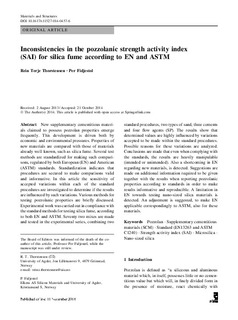| dc.contributor.author | Thorstensen, Rein Terje | |
| dc.contributor.author | Fidjestøl, Per | |
| dc.date.accessioned | 2014-12-09T11:34:00Z | |
| dc.date.available | 2014-12-09T11:34:00Z | |
| dc.date.issued | 2014 | |
| dc.identifier.issn | 1359-5997 | |
| dc.identifier.uri | http://hdl.handle.net/11250/226874 | |
| dc.description | Published version of an article in the journal: Materials and Structures. Also available from the publisher at: http://dx.doi.org/10.1617/s11527-014-0457-6 Open Access | nb_NO |
| dc.description.abstract | New supplementary cementitious materials claimed to possess pozzolan properties emerge frequently. This development is driven both by economic and environmental pressures. Properties of new materials are compared with those of materials already well known, such as silica fume. Several test methods are standardized for making such comparisons, regulated by both European (EN) and American (ASTM) standards. Standardization indicates that procedures are secured to make comparisons valid and informative. In this article the sensitivity of accepted variations within each of the standard procedures are investigated to determine if the results are influenced by such variations. Various methods for testing pozzolanic properties are briefly discussed. Experimental work was carried out in compliance with the standard methods for testing silica fume, according to both EN and ASTM. Seventy two mixes are made and tested in the experimental series, combining two standard procedures, two types of sand, three cements and four flow agents (SP). The results show that determined values are highly influenced by variations accepted to be made within the standard procedures. Possible reasons for these variations are analyzed. Conclusions are made that even when complying with the standards, the results are heavily manipulable (intended or unintended). Also a shortcoming in EN regarding new materials, is detected. Suggestions are made on additional information required to be given together with the results when reporting pozzolanic properties according to standards in order to make results informative and reproducible. A limitation in EN towards testing nano-sized silica materials is detected. An adjustment is suggested, to make EN applicable correspondingly to ASTM, also for these materials. | nb_NO |
| dc.language.iso | eng | nb_NO |
| dc.publisher | Springer | nb_NO |
| dc.subject | pozzolan | nb_NO |
| dc.subject | supplementary cementitious materials (SCM) | nb_NO |
| dc.subject | standard (EN13263 and ASTM C1240) | nb_NO |
| dc.subject | strength activity index (SAI) | nb_NO |
| dc.subject | microsilica | nb_NO |
| dc.title | Inconsistencies in the pozzolanic strength activity index (SAI) for silica fume according to EN and ASTM | nb_NO |
| dc.type | Journal article | nb_NO |
| dc.type | Peer reviewed | nb_NO |
| dc.subject.nsi | VDP::Technology: 500::Materials science and engineering: 520 | nb_NO |
| dc.source.pagenumber | 1-12 | nb_NO |
| dc.source.journal | Materials and Structures | nb_NO |
| dc.identifier.doi | 10.1617/s11527-014-0457-6 | |
